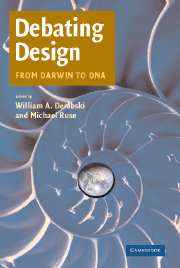Book contents
- Frontmatter
- Contents
- Notes on Contributors
- Debating Design
- INTRODUCTION
- PART I DARWINISM
- PART II COMPLEX SELF-ORGANIZATION
- PART III THEISTIC EVOLUTION
- PART IV INTELLIGENT DESIGN
- 17 The Logical Underpinnings of Intelligent Design
- 18 Information, Entropy, and the Origin of Life
- 19 Irreducible Complexity
- 20 The Cambrian Information Explosion
- Index
- References
18 - Information, Entropy, and the Origin of Life
Published online by Cambridge University Press: 05 June 2012
- Frontmatter
- Contents
- Notes on Contributors
- Debating Design
- INTRODUCTION
- PART I DARWINISM
- PART II COMPLEX SELF-ORGANIZATION
- PART III THEISTIC EVOLUTION
- PART IV INTELLIGENT DESIGN
- 17 The Logical Underpinnings of Intelligent Design
- 18 Information, Entropy, and the Origin of Life
- 19 Irreducible Complexity
- 20 The Cambrian Information Explosion
- Index
- References
Summary
INTRODUCTION
Darwin's theory of evolution and the development of the Second Law of Thermodynamics by Clausius, Maxwell, Boltzmann, and Gibbs are two of the three major scientific discoveries of the nineteenth century. Maxwell's field equations for electricity and magnetism are the third. The laws of thermodynamics have had a unifying effect in the physical sciences similar to that of the theory of evolution in the life sciences. What is intriguing is that the predictions of one seem to contradict the predictions of the other. The Second Law of Thermodynamics suggests a progression from order to disorder, from complexity to simplicity, in the physical universe. Yet biological evolution involves a hierarchical progression to increasingly complex forms of living systems, seemingly in contradiction to the Second Law of Thermodynamics.
In his great book The Nature of the Physical World, Arthur Eddington (1928, 74) says, “If your theory is found to be against the second law of thermodynamics, I can give you no hope; there is nothing for it but to collapse in deepest humiliation.” But while nonliving systems dutifully obey the Second Law of Thermodynamics, living systems seem to live in defiance of it. In fact, this is one of the simplest ways of distinguishing living from nonliving systems. Molton (1978, 147) defines life as “regions of order that use energy to maintain their organization against the disruptive force of entropy.”
- Type
- Chapter
- Information
- Debating DesignFrom Darwin to DNA, pp. 331 - 351Publisher: Cambridge University PressPrint publication year: 2004
References
- 4
- Cited by



